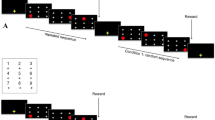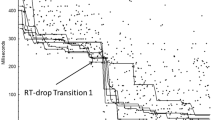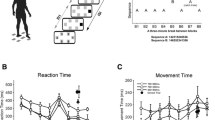Abstract
With a repeated sequence of stimuli, performance in a serial reaction-time task improves more than with a random sequence. The difference has been taken as a measure of implicit sequence learning. Implicit sequence learning is impaired when a secondary task is added to the serial RT task. In the first experiment, secondary-task effects on different types of sequences were studied to test the hypothesis that the learning of unique sequences (where each sequence element has a unique relation to the following one) is not impaired by the secondary task, while the learning of ambiguous sequences is. The sequences were random up to a certain order of sequential dependencies, where they became deterministic. Contrary to the hypothesis, secondary-task effects on the learning of unique sequences were as strong or stronger than such effects on the learning of ambiguous sequences. In the second experiment a hybrid sequence (with unique as well as ambiguous transitions) was used with different secondary tasks. A visuo-spatial and a verbal memory task did not interfere with the learning of the sequence, but interference was observed with an auditory go/no-go task in which high- and low-pitched tones were presented after each manual response and a foot pedal had to be pressed in response to high-pitched tones. Thus, interference seems to be specific to certain secondary tasks and may be related to memory processes (but most likely not to visuo-spatial and verbal memory) or to the organization of sequences, consistent with previous suggestions.
Similar content being viewed by others
References
Annett, J. (1986). On knowing how to do things. In H. Heuer & C. Fromm (Eds.),Generation and modulation of action patterns (pp. 187–200). Berlin: Springer.
Annett, J. (1995), Motor imagery: perception or action?Neuropsychologia, 33, 1395–1417.
Baddeley, A. D. (1986).Working memory, Oxford: Oxford University Press.
Baddeley, A. D., & Lieberman, K. (1980). Spatial working memory, In R. S. Nickerson (Ed.),Attention and Performance VII (pp. 521–539), Hillsdale, N, J.: Erlbaum.
Baddeley, A. D., Grant, S., Wight, E., & Thomson, N. (1975). Imagery and visual working memory. In P. M. A. Rabbitt & S. Dornic (Eds.),Attention and Performance V (pp. 205–217), New York: Academic Press.
Berry, D. C., & Broadbent, D, E. (1988). Interactive tasks and the implicit-explicit distinction.British Journal of Psychology, 79, 251–272.
Brooks, L. R. (1967). The suppression of visualization in reading.Quarterly Journal of Experimental Psychology, 19, 289–299.
Cleeremans, A., & McClelland, J. L. (1991). Learning the structure of event sequences.Journal of Experimental Psychology: General, 120, 235–253.
Cohen, A., Ivry, R. L. & Keele, S. W. (1990). Attention and structure in sequence learning,Journal of Experimental Psychology: Learning, Memory, and Cognition, 16, 17–30.
Curran, T., & Keele, S. W. (1993). Attentional and nonattentional forms of sequence learning.Journal of Experimental Psychology: Learning, Memory, and Cognition, 19, 189–202.
Dienes, Z., Broadbent, D., & Berry, D. (1991). Implicit and explicit knowledge bases in artificial grammar learning.Journal of Experimental Psychology: Learning, Memory, and Cognition, 17, 875–887.
Engelkamp, J., (1991).Das menschliche Gedächtnis. Das Erinnern von Sprache. Bildern und Handlungen (2nd ed.). Göttingen: Hogrefe.
Frensch, P. A., Buchner, A., & Lin, J. (1994). Implicit learning of unique and ambiguous serial transitions in the presence and absence of a distractor task.Journal of Experimental Psychology: Learning, Memory, and Cognition, 20, 567–584.
Goschke, T, (1994). Prozedurales Lernen von strukturierten Ereignissequenzen. Paper read at the Workshop “Sequenzlernen, Bewußtsein und Aufmerksamkeit”, Schwerte.
Grafton, S. T., Hazeltine, E., & Ivry, R. (in press). Functional mapping of sequence learning in normal humans.Journal of Cognitive Neuroscience.
Hay, J. C. (1974). Motor transformation learning, Perception, 3, 487–496.
Hayes, N., & Broadbent, D. E. (1988). Two modes of learning for interactive tasks.Cognition, 28, 249–276.
Heuer, H. (1983).Bewegungslernen. Stuttgart: Kohlhammer.
Heuer, H. (1985). Some points of contact between models of central capacity and factor analytic models.Acta Psychologica, 60, 135–155.
Heuer, H. (1989). A multiple-representations' approach to mental practice of motor skills. In B. Kirkcaldy (Ed.),Normalities and abnormalities in human movement (pp. 36–57), Basel: Karger.
Heuer, H. (1991). Motor constraints in dual-task performance. In D. L. Damos (Ed.),Multiple-task performance (pp. 173–204), London: Taylor & Francis.
Heuer, H. (1996). Doppeltätigkeiten. In O. Neumann & A. F. Sanders (Eds.),Enzyklopädie der Psychologie C II 2: Aufmerksamkeit (pp. 163–218). Göttingen: Hogrefe.
Keele, S. W., & Jennings, P. J. (1992). Attention in the representation of sequence: Experiment and theory.Human Movement Science, 11, 125–138.
Kerr, B. (1973). Processing demands during mental operations.Memory & Cognition, 1, 401–412.
Logie, R., Baddeley, A. D., Mane, A., Donchin, E., & Sheptak, R. (1989).Working memory in the acquisition of complex cognitive skills.Acta Psychologica, 71, 53–87.
Navon, D., & Gopher, D. (1979), On the economy of the human processing system.Psychological Review, 86, 214–255.
Nissen, M. J., & Bullemer, P. (1987). Attentional requirements for learning: Evidence from performance measures.Cognitive Psychology, 1987, 1–32.
Povel, D.-J. & Collard, R. (1982). Structural factors in patterned finger tapping.Acta Psychologica, 52, 107–123.
Reber, A. S. (1989). Implicit learning and tacit knowledge.Journal of Experimental Psychology: General, 118, 219–235.
Reber, A. S. (1992). The cognitive unconscious: An evolutionary perspective.Consciousness & Cognition, 1, 93–133.
Rosenbaum, D. A., Kenny, S. B., & Derr, M. A. (1983). Hierarchical control of rapid movement sequences.Journal of Experimental Psychology: Human Perception and Performance, 9, 86–102.
Schmidt, R. A. (1988).Motor control and learning: A behavioral emphasis, Champaign, III.: Human Kinetics Publishers.
Seger, C. A. (1994),Implicit learning.Psychological Bulletin, 115, 163–196.
Stadler, M. A. (1992). Statistical structure and implicit serial learning.Journal of Experimental Psychology: Learning, Memory, and Cognition, 18, 318–327.
Stadler, M. A. (1995). Role of attention in implicit learning.Journal of Experimental Psychology: Learning, Memory, and Cognition, 21, 674–685.
Willingham, D. B., Nissen, M. J., & Bullemer, P. (1989). On the development of procedural knowledge.Journal of Experimental Psychology: Learning, Memory, and Cognition, 15, 1047–1060.
Zießler, M., Hänel, K., & Sachse, D. (1990). The programming of structural properties of movement sequences.Psychological Research, 52, 347–358.
Author information
Authors and Affiliations
Rights and permissions
About this article
Cite this article
Heuer, H., Schmidtke, V. Secondary-task effects on sequence learning. Psychol. Res 59, 119–133 (1996). https://doi.org/10.1007/BF01792433
Received:
Accepted:
Issue Date:
DOI: https://doi.org/10.1007/BF01792433




